Playing is learning. This probably isn’t news to the people who read this blog, but it bears repeating because it’s easy to forget. Kids play all the time at home, and it can become something that happens in the background that we don’t think about. At the library, we place a priority on play. We make it a point to invite kids and grownups to play together. If asked, I could go on and on about the ways that pretend play, in particular, helps kids develop early literacy skills, but my goal with this post is to show off some of the fun pretend play themes I’ve had at my library over the last year. So here goes! :)
Narrative Skills:
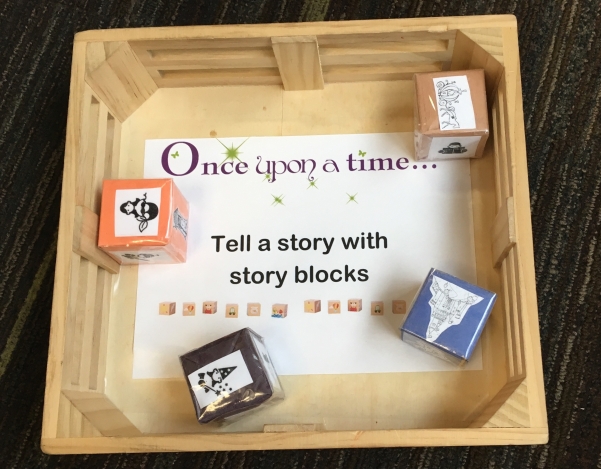 We celebrated Picture Book Month with an Enchanted Forest theme. Kids could dress up as fairy tale characters or use the stuffed animals to tell their own version of familiar stories. The story cubes could spark a creative retelling that mixes up all sorts of fairy tale elements. I made these myself by covering some wooden blocks with construction paper and tape, but you can also buy story cubes or story sticks aimed at preschoolers to encourage storytelling.
We celebrated Picture Book Month with an Enchanted Forest theme. Kids could dress up as fairy tale characters or use the stuffed animals to tell their own version of familiar stories. The story cubes could spark a creative retelling that mixes up all sorts of fairy tale elements. I made these myself by covering some wooden blocks with construction paper and tape, but you can also buy story cubes or story sticks aimed at preschoolers to encourage storytelling.
Social Skills:
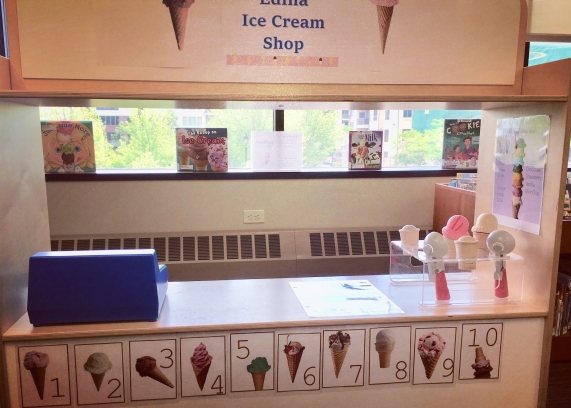 In the grocery store, the ice cream shop, and other community based play spaces, kids can imagine themselves in various roles. They can take turns being proprietor or a customer, seeing the interactions from different roles and developing empathy for experiences outside of their own.
In the grocery store, the ice cream shop, and other community based play spaces, kids can imagine themselves in various roles. They can take turns being proprietor or a customer, seeing the interactions from different roles and developing empathy for experiences outside of their own.
Vocabulary:
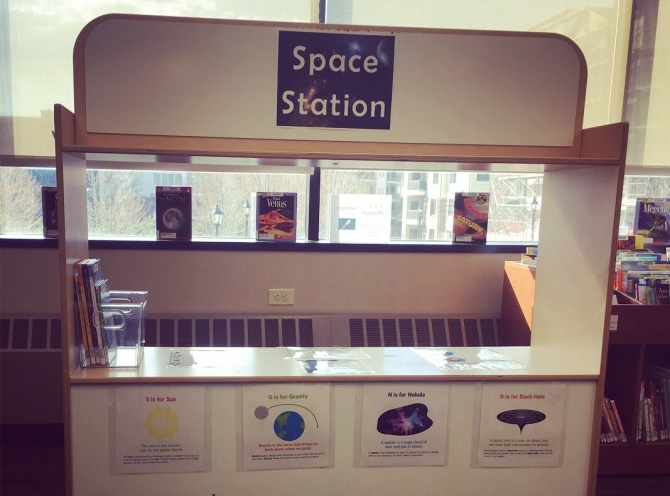 In the Fix It Shop, we named the tools. In the Sense Lab, we encouraged the use of descriptive language as kids explored the world with their senses. Our Space Station offered various science words. Don’t underestimate kids’ willingness to learn complex vocabulary if they are interested in the topic!
In the Fix It Shop, we named the tools. In the Sense Lab, we encouraged the use of descriptive language as kids explored the world with their senses. Our Space Station offered various science words. Don’t underestimate kids’ willingness to learn complex vocabulary if they are interested in the topic!
Print Awareness:
 In the community based play spaces (World Café, Ice Cream Shop, etc), the menus and other signage are examples of the way that we interact with printed words as we life our lives. Understanding just how much we rely on printed language is an important part of learning to read.
In the community based play spaces (World Café, Ice Cream Shop, etc), the menus and other signage are examples of the way that we interact with printed words as we life our lives. Understanding just how much we rely on printed language is an important part of learning to read.
Print Motivation:
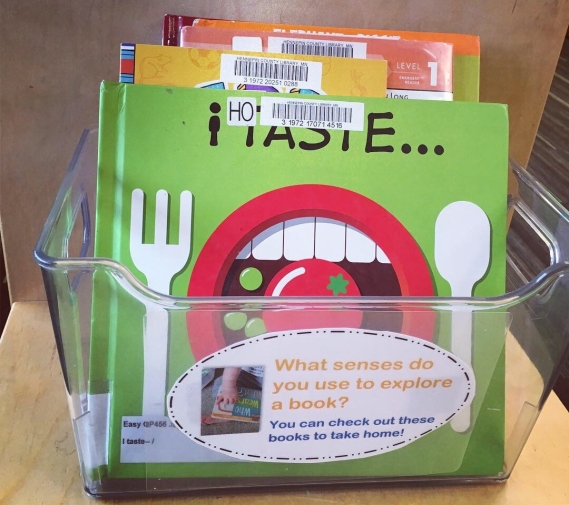 Kids and caregivers are always encouraged to learn more about the topics with books. Learning to read is hard work, and if kids are interested in the topics they are reading about, they be much more motivated.
Kids and caregivers are always encouraged to learn more about the topics with books. Learning to read is hard work, and if kids are interested in the topics they are reading about, they be much more motivated.
Letter Knowledge:
 Exploring shapes and sorting objects based on likes and differences is a first step to letter knowledge. Our grocery store featured pictures of letters made out of food, and the Sense Lab encouraged sorting objects based on how they feel.
Exploring shapes and sorting objects based on likes and differences is a first step to letter knowledge. Our grocery store featured pictures of letters made out of food, and the Sense Lab encouraged sorting objects based on how they feel.
Phonological Awareness:
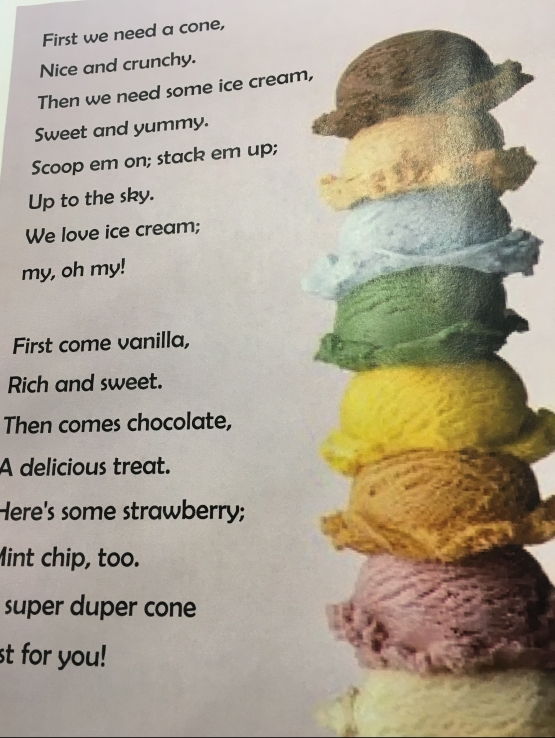 Singing songs and chanting rhymes help kids hear the sounds of words more clearly than in regular speech. We included the words to a rhyme in our Ice Cream Shop and our Space Station to add an opportunity to build phonological awareness while at play.
Singing songs and chanting rhymes help kids hear the sounds of words more clearly than in regular speech. We included the words to a rhyme in our Ice Cream Shop and our Space Station to add an opportunity to build phonological awareness while at play.
Stay tuned for an upcoming post about my library’s pretend play space relates to early science skills!

 Last time I posted about books that were not getting enough love at the library, I featured
Last time I posted about books that were not getting enough love at the library, I featured  And then there are those sequels I can’t not read.
And then there are those sequels I can’t not read. As I was reading Goose Girl aloud to my ten-year-old, I started thinking about all the stories that start with princesses (or other noble ladies) facing arranged marriages. The librarian in me thought that might make a good list or maybe display, so I decided to see how many I could find. Somewhere along the way, I came across a book called The Kiss of Deception by Mary Pearson. It sounded interesting.
As I was reading Goose Girl aloud to my ten-year-old, I started thinking about all the stories that start with princesses (or other noble ladies) facing arranged marriages. The librarian in me thought that might make a good list or maybe display, so I decided to see how many I could find. Somewhere along the way, I came across a book called The Kiss of Deception by Mary Pearson. It sounded interesting. When the book ended, I felt like my interest in the story was far from sated. I needed book two like I’ve never needed a sequel before, maybe ever. The few days it took to get it from the library felt like a lifetime, and once I had my hands on it, I gobbled up the story as fast as I could. I was thrilled to find out that I didn’t have to wait for book three. It was checked in at my library. I was less thrilled to discover that it was nearly 700 pages, but that wasn’t going to stop me from following Princess Lia’s story wherever it took me.
When the book ended, I felt like my interest in the story was far from sated. I needed book two like I’ve never needed a sequel before, maybe ever. The few days it took to get it from the library felt like a lifetime, and once I had my hands on it, I gobbled up the story as fast as I could. I was thrilled to find out that I didn’t have to wait for book three. It was checked in at my library. I was less thrilled to discover that it was nearly 700 pages, but that wasn’t going to stop me from following Princess Lia’s story wherever it took me.

 I rarely read sequels. Who has time for that? (Says the person who has also posted about rereading books multiple times just ‘cause.) The truth is that no matter what I say about lack of time, if I really want to read something, I’ll make the time . . .eventually. If I am being honest, I would say that I rarely bother with sequels because they are usually disappointing.
I rarely read sequels. Who has time for that? (Says the person who has also posted about rereading books multiple times just ‘cause.) The truth is that no matter what I say about lack of time, if I really want to read something, I’ll make the time . . .eventually. If I am being honest, I would say that I rarely bother with sequels because they are usually disappointing. Thunderhead (sequel to Scythe) by Neal Shusterman – Both Scythe and Thunderhead were rather outside of my usual choices, but I could not put either of them down. Seriously, if you like dystopian novels that explore ethics and ideas while telling a story that is brutal and compelling, you need to read both of these books. Actually the School Library Journal called Thunderhead, “A rare sequel that is even better than the first book.” I’m not sure I’d go that far myself, but I will say that I will absolutely be reading the third installment as soon as it comes out, which is a super rarity for me.
Thunderhead (sequel to Scythe) by Neal Shusterman – Both Scythe and Thunderhead were rather outside of my usual choices, but I could not put either of them down. Seriously, if you like dystopian novels that explore ethics and ideas while telling a story that is brutal and compelling, you need to read both of these books. Actually the School Library Journal called Thunderhead, “A rare sequel that is even better than the first book.” I’m not sure I’d go that far myself, but I will say that I will absolutely be reading the third installment as soon as it comes out, which is a super rarity for me.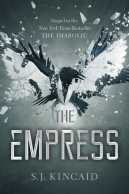 The Empress (sequel to The Diabolic) by S.J. Kincaid – Perhaps a bit like Scythe and Thunderhead, this science fiction story explores big ideas (what is personhood, science vs. religion, etc.) in a world that is harsh and full of deception. But here the focus is on the political intrigue at the emperor’s court where Nemesis, a genetically engineered bodyguard, is sent to impersonate a Senator’s daughter to protect her. There are unexpected twists and turns in both books, and by the end of The Empress, I am not even sure what to expect for the third book.
The Empress (sequel to The Diabolic) by S.J. Kincaid – Perhaps a bit like Scythe and Thunderhead, this science fiction story explores big ideas (what is personhood, science vs. religion, etc.) in a world that is harsh and full of deception. But here the focus is on the political intrigue at the emperor’s court where Nemesis, a genetically engineered bodyguard, is sent to impersonate a Senator’s daughter to protect her. There are unexpected twists and turns in both books, and by the end of The Empress, I am not even sure what to expect for the third book.







 I found this book shelved with the nonfiction picture books at my library. Next to books offering information about weather for preschoolers and young children. This 100+ page volume stood out as different from the sea of 32 page picture books. At a glance, I thought perhaps it might be misshelved. Looking further into the book, I thought perhaps there was no section for this book in my library. No one place it belonged.
I found this book shelved with the nonfiction picture books at my library. Next to books offering information about weather for preschoolers and young children. This 100+ page volume stood out as different from the sea of 32 page picture books. At a glance, I thought perhaps it might be misshelved. Looking further into the book, I thought perhaps there was no section for this book in my library. No one place it belonged. I didn’t manage to post anything on this blog all summer long, but I did manage to write this summer. The credit goes to my ten-year-old daughter. Story Club was her idea.
I didn’t manage to post anything on this blog all summer long, but I did manage to write this summer. The credit goes to my ten-year-old daughter. Story Club was her idea.
 Speaking of wordplay and laugh-out-loud humor,
Speaking of wordplay and laugh-out-loud humor,  There are two types of people in the world: people who reread books and people who don’t.
There are two types of people in the world: people who reread books and people who don’t. In addition to the teen romances I mentioned above, my next choice for a comfort read is historical fiction. I’ve blogged about my interest in historical fiction often enough that this probably doesn’t surprise anyone. But there is something I find incredibly comforting in getting completely out of your own time period. I have recently reread a couple of favorites: The Lost Girl of Astor Street (historical mystery/romance) and No Shame No Fear (historical/romance), and I can highly recommend both to readers whose tastes run similar to mine. ;)
In addition to the teen romances I mentioned above, my next choice for a comfort read is historical fiction. I’ve blogged about my interest in historical fiction often enough that this probably doesn’t surprise anyone. But there is something I find incredibly comforting in getting completely out of your own time period. I have recently reread a couple of favorites: The Lost Girl of Astor Street (historical mystery/romance) and No Shame No Fear (historical/romance), and I can highly recommend both to readers whose tastes run similar to mine. ;)